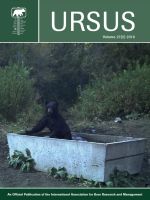Bears (Ursidae) have extensive home ranges and may move long distances, thereby potentially serving as hosts to, and vectors of, large numbers of ticks. We assessed the composition of the parasitizing tick community on American black bears (Ursus americanus) to discern hard tick species capable of successfully feeding, which is a necessary step for tick reproduction. We counted ticks from free-ranging, live-trapped, or road-killed black bears in southern Missouri, USA, during 2015, and collected a subset of engorged ticks (n = 967). All bears (n = 17) were infected with ticks (n = 6,993), with a mean intensity of 411 ticks/bear, of which 14% were engorged females. The infracommunity size of engorged ticks was 57 ticks/bear. From these engorged ticks, we identified 5 species: Amblyomma americanum, A. maculatum, Dermacentor variabilis, D. albipictus, and Ixodes scapularis. Amblyomma americanum was the most common species, collected on all surveyed bears, and represented 58.2% of engorged ticks, whereas D. albipictus and A. maculatum were the least common species, collected from only 3 and 4 bears, respectively, and representing 4.7% and 2.4% of engorged ticks, respectively. Our data suggest that individual black bears have the potential to host large numbers of ticks to engorgement, and may be important vectors for tick dispersal and for the maintenance of tick populations.
How to translate text using browser tools
1 January 2017
Community composition of Ixodid ticks parasitizing American black bears in Missouri, USA
Harith S. Al-Warid,
Jeff Beringer,
Tim L. Hiller,
Jerrold L. Belant,
Matthew E. Gompper
ACCESS THE FULL ARTICLE

Ursus
Vol. 27 • No. 2
January 2017
Vol. 27 • No. 2
January 2017
Amblyomma
American black bears
Dermacentor
Ixodes
Missouri
Ozark Highlands
parasites




